![]() 1st Battalion 22nd Infantry
1st Battalion 22nd Infantry ![]()
The Naming of Camp Radcliff
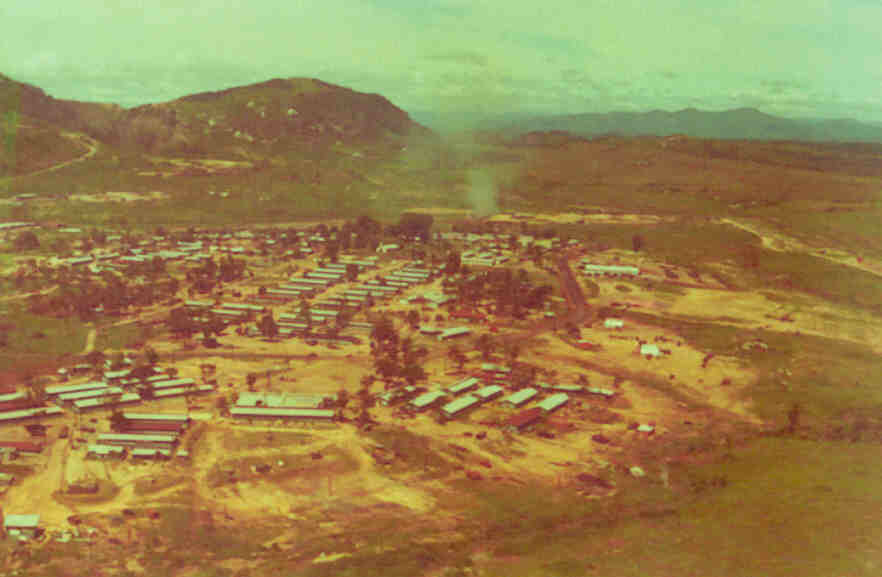
Camp Radcliff, An Khe, Binh Dinh Province, Republic of Vietnam
Camp Radcliff was
originally built as the base for the 1st Cavalry Division. It was
home for the 4th Infantry Division,
and thus 1st Battalion, 22nd Infantry from 1969-1970. Many
Regulars are well familiar with the base camp at An Khe,
and its landmarks, such as Hon Cong Mountain and "The Golf
Course".
In August 1965, Major Donald G. Radcliff was the executive officer of the 1st Squadron, 9th Cavalry, 1st Cavalry Division, and a member of the site selection team that scoured the countryside in Binh Dinh Province to find the ideal location for the 1st Cavalry Division's base camp. The team was in Vietnam in advance of the Division, who were still aboard ship, travelling across the Pacific. The site selection team was under command of Brigadier General John M. Wright.
When it was learned by the team that the 7th Marines were planning a major strike against the enemy, Major Radcliff volunteered to fly a mission in support of Marine troop lifts. Intelligence indicated that the 1st VC Regiment was massing for an attack on the Marine base at Chu Lai in Quang Tin Province. Rather than prepare defenses and brace for the attack, the Marines decided to meet the enemy on their own terms and launch a preemptive attack, code named Operation Starlite. Operation Starlite, the largest planned US military operation in Vietnam to that time, was to be a combined amphibious/air assault operation against the Viet Cong regiment twelve miles south of Chu Lai. The assault included two amphibious landing sites and three helicopter landing zones named LZ Red, LZ White and LZ Blue.
At dawn 18 August 1965, the quiet shoreline of southern Quang Tin Province suddenly erupted in a volley of explosions from artillery and offshore guns, followed by massive aerial bombardment. At 0630 the Marines hit the beaches while an armada of helicopters swooped in from the west. The Marines encountered little resistance on the coast and started their march inland. The troops arriving at Landing Zone Red met almost no resistance and disembarked without incident. At LZ White the Marines drew fire from a nearby ridge line but managed to land and clear the area quite readily.
Landing Zone Blue, however, was a different story. Major Radcliff was piloting a UH-1B helicopter gunship in escort of the LZ Blue airmobile assault. Unbeknownst to the trooplift, the landing zone was surrounded by the 60th VC Battalion, lying in wait. As the aircraft arrived at the landing zone, Radcliff realized that the lead troop-carrying aircraft was the target of heavy automatic weapons fire. He immediately pinpointed the Viet Cong position and placed accurate, devastating, suppressive fire on the opposing enemy forces. With his quick reaction, Major Radcliff saved countless lives and enabled the troop transports to land. As the troops deployed on the landing zone, Radcliff hovered nearby to insure their safety. Heavy fire was directed at the Major's helicopter, and as bullets tore through his aircraft, Major Radcliff was mortally wounded. The gallant, thirty-seven year old officer lost his life at the controls of his gunship during his baptism of fire in Vietnam.
In late August of 1965 an advanced party of senior NCO's and field grade officers of the 1st Cav Division were sent to the newly selected base camp at An Khe. General Wright had selected a site in a remote valley in the shadow of Hon Cong Mountain, surrounded by the hills of the Central Highlands, to accomodate the 450 helicopters of the 1st Cavalry Division.
The location was ideal because of near perfect climatic conditions for an airmobile unit, and the strategic location allowed for the defense and control of the Central Highlands. The general knew that a dirt airstrip would create dust storms during takeoffs and landings, so the underlying grass and brush would have to stay, but be cut close to the ground.
(Website Ed., General Wright
called the clearing his advance party would create a "golf
course" devoid of trees but carpeted with grass.
The name stuck, and this area at Camp Radcliff would forever be
called The Golf Course.)
The "golf course" extended from the center of the helicopter landing area in all directions, beyond cantonment areas to the defense perimeter known as the "green line". While everyone from officers and senior NCO's to Privates swung grub hooks to clear the six-square kilometer area, soldiers on loan from the 1st Brigade, 101st Airborne guarded the perimeter.
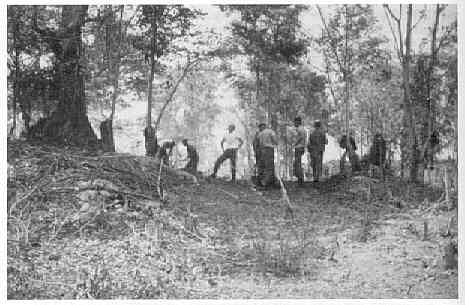
Men of the 1st Cav's advance team clear brush to create the "golf course".
Above photo and story taken from:
VIETNAM Military Lore 1959-1973.....Another Way To Remember
by Master Sergeant Ray A. Bows, U.S. Army, Retired
edited by Stephen Bows
Copyright 1988 by Bows & Sons Publishing.
Used by personal permission of the author
On 1 September 1965, Major Radcliff was posthumously awarded the Distinguished Flying Cross on US Army Vietnam General Orders Number 372. The US Ambassador to Vietnam, Henry Cabot Lodge, flew from Saigon to offically dedicate the new base as Camp Radcliff in formal ceremonies on 21 February 1966. The nickname "the Golf Course", synonymous with Camp Radcliff, stood as a tribute to the tenacity and "can do" spirit of the 1st Cav's advance team, many of whom later lost their lives in combat.
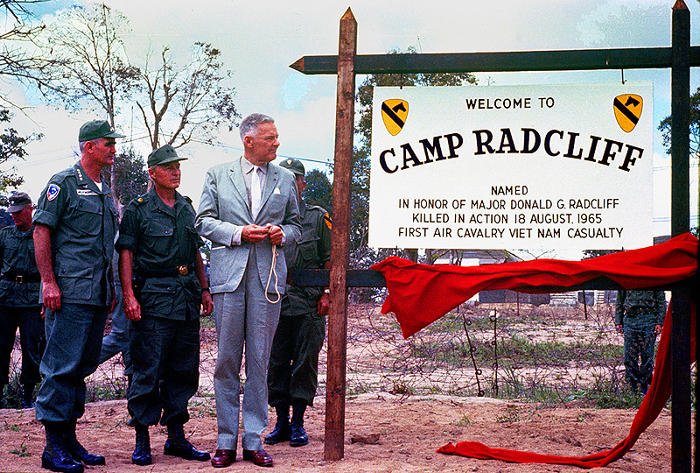
The formal dedication of
Camp Radcliff, attended by Ambassador Henry Cabot Lodge, Jr., and
General William Westmoreland,
as well as MG Harry W.O. Kinnard, the Air Cav Division commander.
Photo courtesy of PFC (later Captain) Marvin J. Wolf.
Marvin J. Wolf was one
of the advance party of 1, 040 soldiers from the Air Cavalry
Division who
built The Golf Course. For an excellent article by him describing
the building of The Golf Course
at Camp Radcliff, go to The War Horse website at the following
link:
Explosives, a Couple of Flamethrowers, and No Ordinary Men Against a Forbidding Jungle
Donald Gordon Radcliff was born on 4 January 1928. His home of record was Louisville, Kentucky.
His name is inscribed on the Vietnam Veterans Memorial on the east wall, panel 2E, line 59.
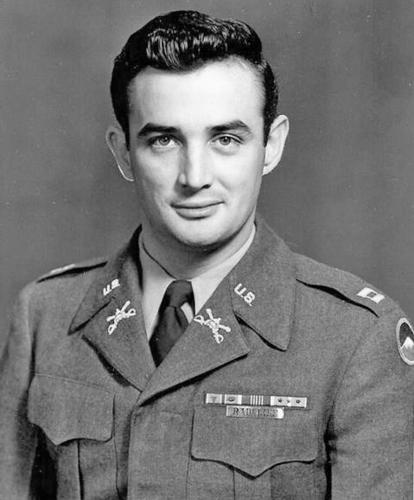
Donald G. Radcliff
From the Vietnam Veterans Memorial Fund website
Donald G. Radcliff is buried at
the Zachary Taylor National Cemetery,
Louisville, Jefferson County, Kentucky, USA
Plot: D, 654LH
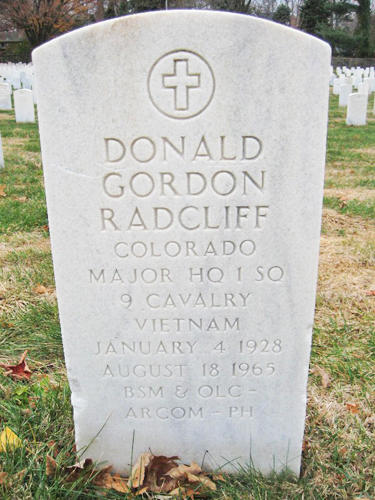
Grave marker for Donald G. Radcliff
Photo by Nancy Simmons Roberson from the Find A Grave website
Top photo courtesy of George Heidt.
Home | Photos | Battles & History | Current |
Rosters & Reports | Medal of Honor | Killed
in Action |
Personnel Locator | Commanders | Station
List | Campaigns |
Honors | Insignia & Memorabilia | 4-42
Artillery | Taps |
What's New | Editorial | Links |